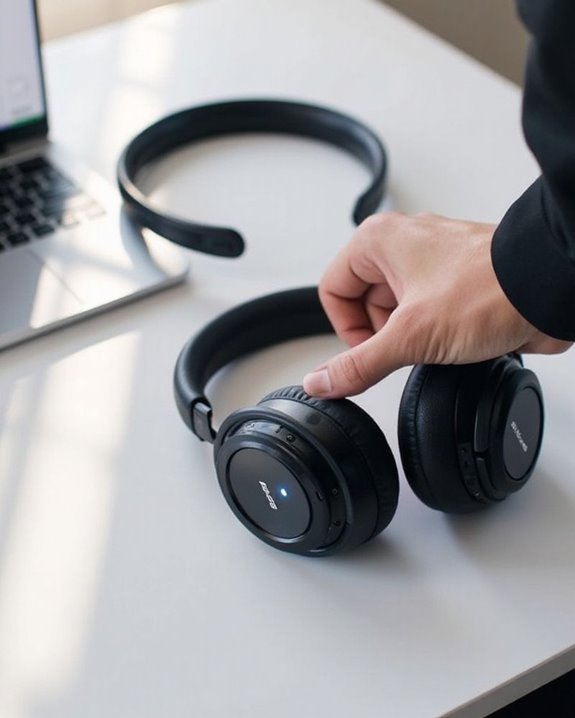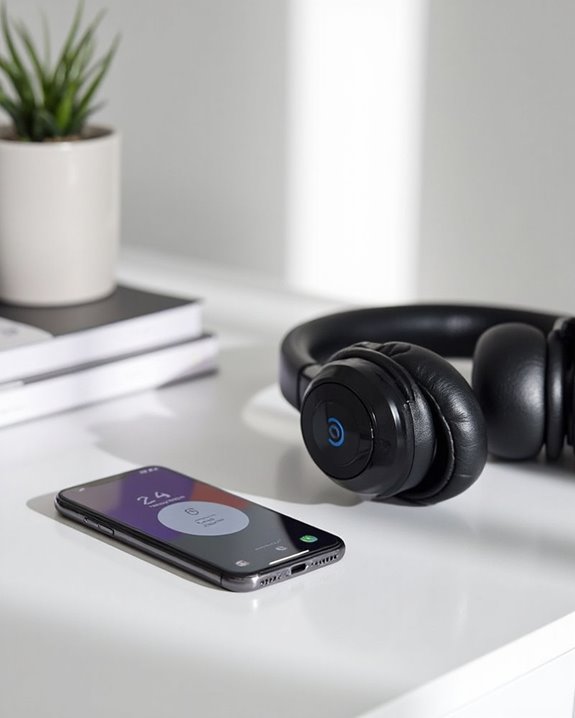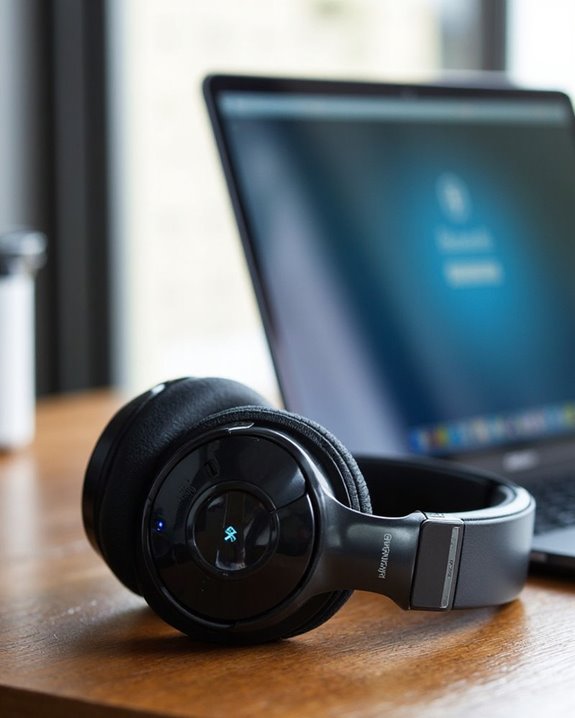Cleaning headphones requires specific materials based on their type: microfiber cloths and mild soap for over-ear models, isopropyl alcohol for in-ear varieties. Begin with a thorough inspection for dirt buildup, worn pads, and moisture damage. Clean headbands with appropriate solutions—diluted shampoo for fabric, conditioning for leather. For ear cushions, apply gentle cleaning solutions with microfiber cloths, while speaker grills require soft-bristle brushes or compressed air. Proper drying in well-ventilated areas prevents damage and extends your device’s lifespan.
Key Takeaways
- Wipe ear cushions with microfiber cloths and diluted mild soap for synthetic materials, or use specialized leather cleaners for genuine leather parts.
- Inspect headphones for dirt buildup, worn ear pads, and moisture damage before cleaning to determine appropriate cleaning approach.
- Clean fabric headbands with diluted shampoo, leather headbands with damp cloth followed by conditioning, and synthetic materials with minimal moisture.
- Sanitize earcup cushions with warm water and gentle soap, using cotton tips for crevices and allowing complete air drying before reattachment.
- For wireless earbuds, clean exteriors with lint-free cloth, use cotton swabs on charging contacts, and let components air dry completely.
Essential Cleaning Materials for Different Headphone Types
The right cleaning supplies are critical for maintaining headphones without causing damage to sensitive components. Different headphone designs require specific cleaning approaches and materials to guarantee proper care.
For over-ear and on-ear models, microfiber cloths and diluted mild soap solutions work effectively on synthetic materials, while specialized leather care products preserve genuine leather parts. DIY Solutions like a soft toothbrush can safely remove debris from crevices without harming drivers.
In-ear headphones benefit from precision tools designed specifically for small components, along with isopropyl alcohol for disinfection. Eco Materials such as reusable microfiber cloths are preferable to disposable wipes for regular maintenance.
Various ear cushion materials—foam, leatherette, vinyl, and velour—each respond best to specific cleaning approaches, with some requiring only dry wiping while others can tolerate mild soap solutions. Additionally, paying attention to safe cleaning products for ear cushions helps maintain the aesthetic and longevity of white headphones.
Pre-Cleaning Inspection: What to Look For
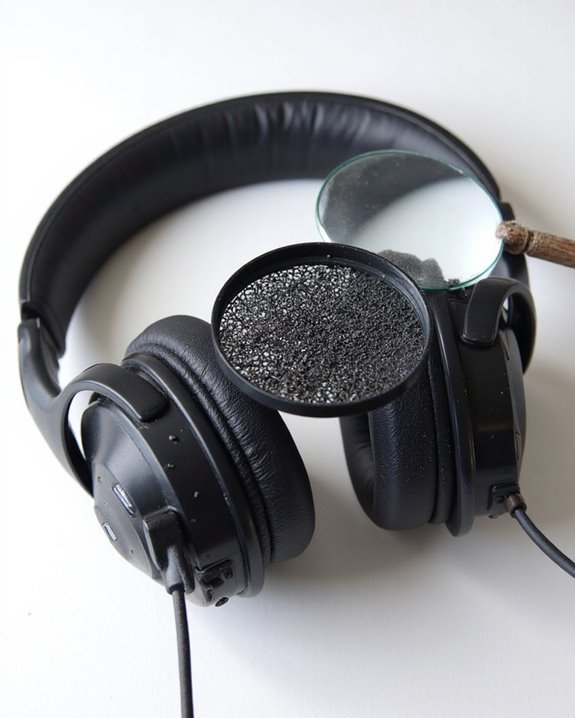
Performing a thorough inspection before cleaning headphones saves time and prevents potential damage to delicate components. Users should examine headphones for accumulated dirt, worn ear pads, and structural damage that may require special attention during cleaning.
Check all functional elements including sound quality, microphone clarity, and button responsiveness to establish a baseline before cleaning begins. Poor Storage Conditions often lead to dust buildup and cable damage, while Travel Effects frequently manifest as structural weaknesses in joints and headbands.
Inspect for hygiene concerns such as earwax accumulation or signs of bacterial growth, particularly if headphones have been shared or stored in humid environments. Finally, look for evidence of moisture exposure or chemical residue from previous cleaning attempts that might require specialized treatment approaches.
Proper Techniques for Cleaning Headbands
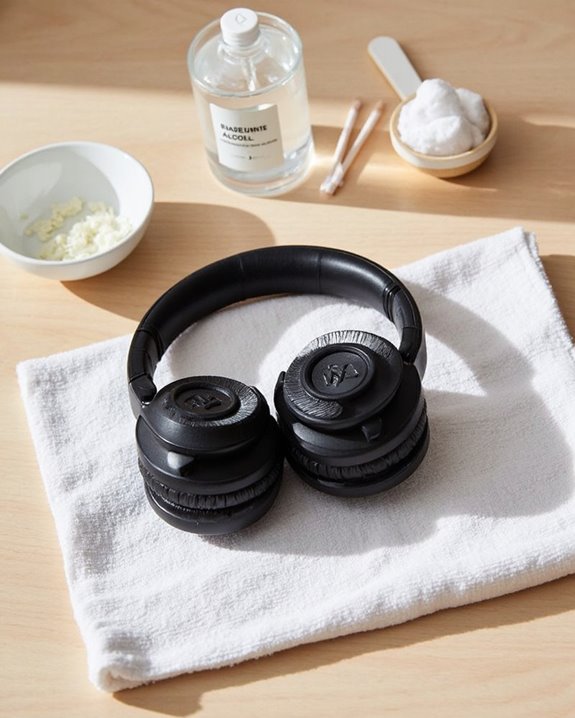
While maintaining headphone hygiene requires attention to all components, headbands demand particular care due to their continuous contact with hair and skin oils. Different materials necessitate specific approaches to cleaning.
For fabric headbands, gentle scrubbing with natural cleaners like diluted mild shampoo is effective for removing accumulated oils. Machine washing may be suitable for some designs, while others require hand washing and air drying.
Leather headbands should never encounter excessive moisture or harsh chemicals. Instead, use a slightly damp cloth followed by conditioning to maintain suppleness.
Synthetic materials typically need only a lightly moistened cloth, with minimal use of cleaning agents. Always remove electronic components before cleaning, particularly from Bluetooth headbands.
For specialty materials like velour or Alcantara, microfiber cloths provide sufficient cleaning power without damaging delicate surfaces.
Sanitizing and Refreshing Earcup Cushions

Maintaining hygiene for earcup cushions requires dedicated attention, as these components make direct contact with skin and absorb oils, sweat, and debris during regular use. Effective earcup sterilization begins with preparing a mild cleaning solution of warm water and gentle soap.
For proper cushion deodorizing, apply the solution using a lightly dampened microfiber cloth rather than soaking the material. Cotton tips prove invaluable for reaching crevices and seams where bacteria accumulate. Non-abrasive cleaners like peroxide can safely sanitize synthetic leather without causing damage.
After cleaning, thoroughly dry cushions by gently pressing between a towel, then allow them to air dry completely before reattachment. Regular maintenance greatly extends cushion lifespan while preventing bacterial growth. For persistent odors or severely soiled cushions, replacement may be the most hygienic solution.
Deep Cleaning Speaker Grills Without Damage

Speaker grill maintenance poses a unique challenge when deep cleaning headphones, as these delicate components protect critical internal parts while collecting significant dust and debris. Recent grill innovations feature intricate designs that enhance sound waves but complicate cleaning procedures.
For effective cleaning without damage, utilize soft-bristle brushes to gently sweep away surface particles. Avoid excessive pressure that might push debris deeper into the mesh. A low-pressure air compressor represents an ideal solution for dislodging stubborn dirt without physical contact.
If headphone design permits, carefully remove the grills for more thorough cleaning. For non-removable grills, consider specialized sound frequency tools that use acoustic vibrations to shake loose particles. This method leverages the same physical principles that allow sound waves to travel through the grills during normal operation.
Maintaining Wireless Earbuds and Their Charging Cases
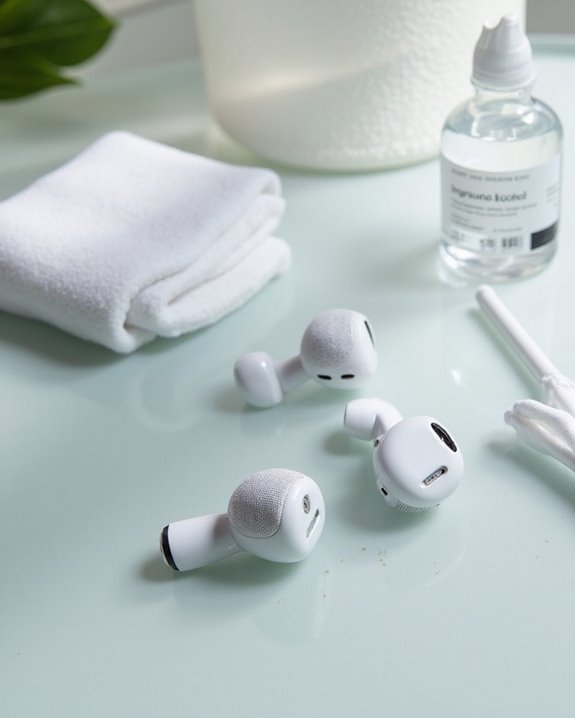
Wireless earbuds present unique cleaning challenges compared to traditional headphones, requiring specialized care for both the earbuds themselves and their charging cases. Users should disconnect earbuds before cleaning and use a slightly dampened lint-free cloth for exterior surfaces, avoiding direct liquid contact with speaker grills.
For proper Battery Care, make sure charging contacts remain clean by gently using cotton swabs to remove debris that could impede connectivity. Never use metal objects or abrasive materials on these delicate components.
Storage Tips include leaving cases open to air dry completely after cleaning, particularly if moisture has been introduced. For tight spaces, silicone cleaning putty or careful use of compressed air can effectively remove dirt without damaging components. Establishing a regular cleaning routine helps maintain best audio quality and extends the lifespan of wireless earbuds. Additionally, choosing earbuds with an IPX7 waterproof rating can help protect your devices from damage during cleaning routines.
Removing Stubborn Grime From Crevices and Joints
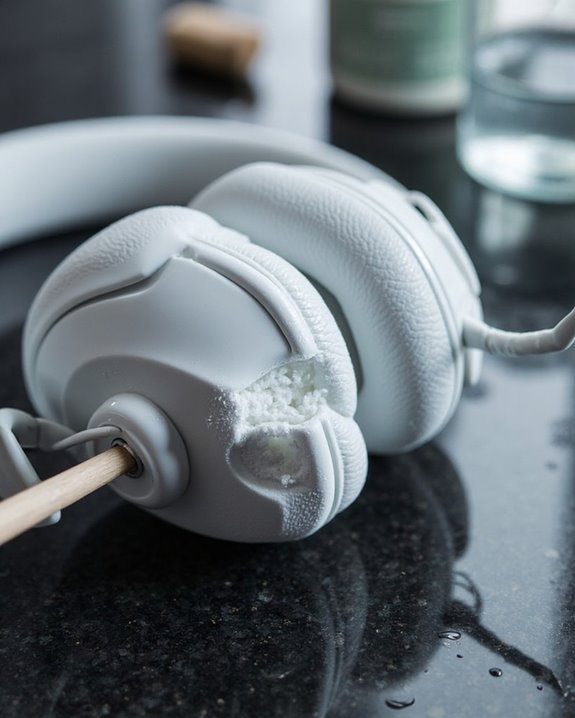
Tackling stubborn grime hiding in headphone crevices requires precision and patience to prevent damage to delicate components. The right Grime Tools make all the difference when working with intricate headphone designs.
For effective Joint Techniques, start with dry cleaning methods using a soft-bristled brush or toothbrush to dislodge and remove loose particles from tight spaces. This approach minimizes moisture exposure to sensitive electronics.
For more persistent dirt, slightly dampen cotton swabs with water or isopropyl alcohol when cleaning non-fabric areas. These tools can reach narrow gaps between buttons and housing joints.
Never use harsh chemicals on headphone components as they can degrade materials and finishes. Always make sure cleaned areas dry completely before reassembling or using the headphones to prevent internal moisture damage.
Safe Drying Methods for Headphone Components
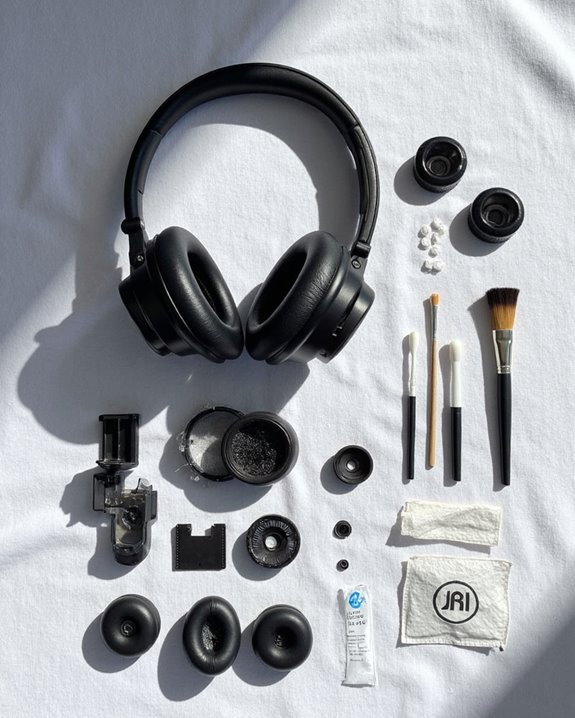
Proper drying techniques form the essential final step in any headphone cleaning process, preventing potential damage from lingering moisture. After cleaning, place components in a well-ventilated area with good humidity control for at least 48 hours, avoiding direct heat sources that could damage sensitive electronics.
For enhanced moisture removal, consider using desiccants like silica gel packs in an airtight container with disassembled parts. The rice immersion method offers another effective option, submerging components in uncooked rice that absorbs moisture through microscopic air pockets.
Throughout the drying process, position headphones for ideal airflow, rotating periodically to prevent moisture from settling. Before reassembly, verify complete dryness through visual inspection. Establish proper dry storage practices after cleaning to maintain headphone longevity and performance quality.
Establishing a Regular Maintenance Schedule
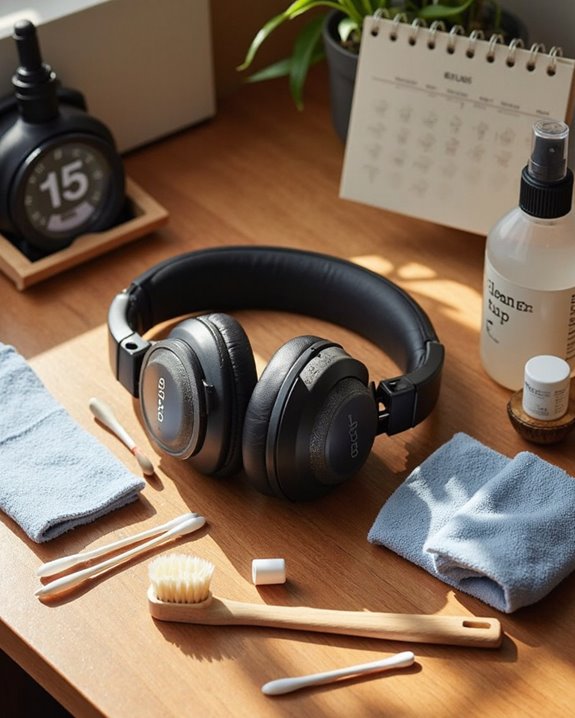
Consistently maintaining headphones extends their lifespan and preserves audio quality while preventing buildup of oils, sweat, and debris that can degrade performance over time. Effective Schedule Planning involves inspecting headphones every 1-2 weeks for visible dirt accumulation and performing deeper cleaning monthly.
Habit Building becomes easier when maintenance activities align with usage patterns. Users should:
- Conduct quick daily checks for visible stains
- Clean ear pads every 100-200 hours of use
- Perform monthly deep cleaning with mild detergents
- Check storage containers seasonally for moisture
Environmental factors also affect cleaning frequency. Headphones used in humid environments or during physical activity require more frequent maintenance. Tracking usage hours helps determine when components like ear pads need replacement, ensuring both peak performance and hygiene. Additionally, selecting headphones with water resistance ratings can reduce the impact of sweat and moisture, simplifying the cleaning process.
When to Replace Versus When to Clean Parts
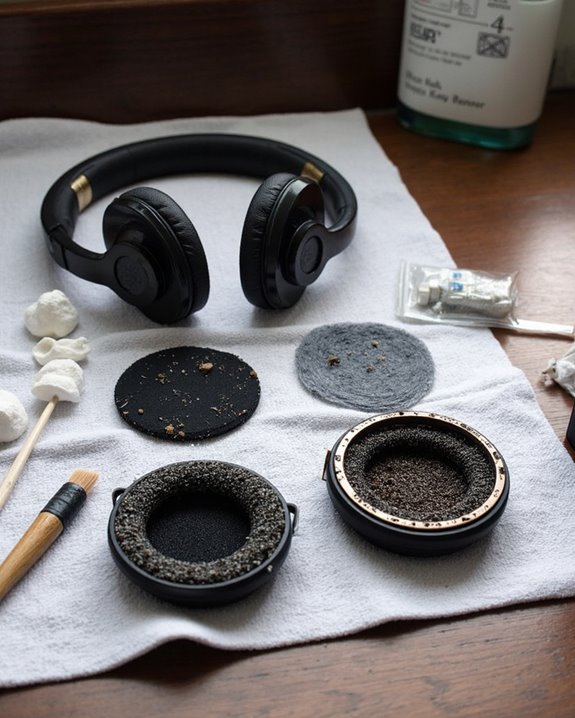
Knowing when to replace versus clean headphone parts represents one of the most challenging aspects of headphone maintenance. Users should watch for specific wear signs including cracking, peeling, or a rough texture on ear pads—all indicators that replacement, not cleaning, is necessary.
Climate impact greatly affects maintenance decisions. Headphones exposed to extreme temperatures or humidity require more frequent assessment, as these conditions accelerate material degradation, particularly in leather components. While cleaning with a soft, damp cloth works for routine maintenance after approximately seven uses, it cannot remedy advanced deterioration.
For best performance and longevity, replace foam tips and ear pads when they no longer respond to cleaning. High-quality replacement parts, though potentially more expensive initially, often prove more economical than frequent replacements or purchasing entirely new headphones.
Frequently Asked Questions
Can I Clean My Headphones With Hydrogen Peroxide?
Hydrogen peroxide isn’t recommended for headphone cleaning due to potential material damage. Hydrogen safety concerns include discoloration and degradation. Peroxide alternatives such as specialized electronics cleaners, soft cloths, or cotton swabs are safer and more effective options.
How Do I Remove Strange Odors From My Headphones?
Odor sources in headphones typically include sweat and bacteria. For deodorizing tips, one can use hydrogen peroxide, mild detergent solutions, or natron to absorb smells. Regular cleaning prevents future odor development.
Are Headphone Cleaning Services Worth the Cost?
Headphone cleaning services offer variable service value depending on the model’s price and usage frequency. Cost analysis suggests they’re worthwhile for expensive models, while budget headphones may not justify the expense compared to DIY methods.
Can I Put Silicone Eartips in the Washing Machine?
Coincidentally, many have lost quality eartips this way. Washing machines pose significant Washing Risks to silicone eartips, potentially damaging their shape and integrity. Proper Silicone Maintenance involves gentle hand-washing with mild soap instead.
How Do I Clean Headphones With Non-Removable Ear Cushions?
For headphones with non-removable ear cushions, proper cushion maintenance involves dry cleaning with a damp cloth using mild soap solution. One should avoid excess moisture and allow cushions to air dry completely before use.


